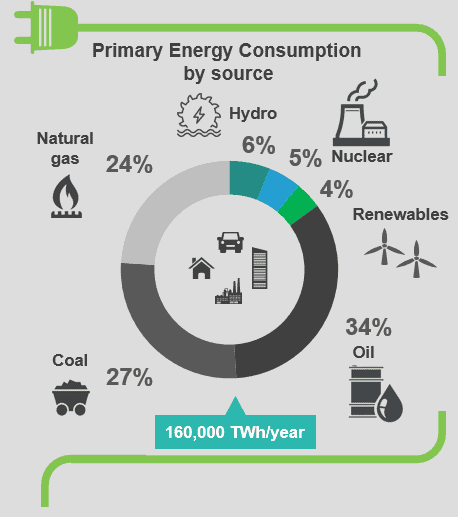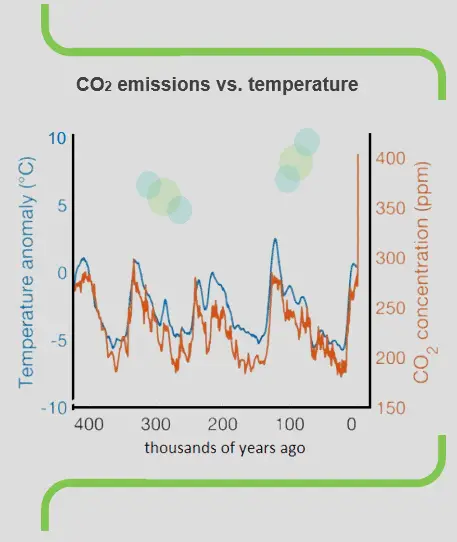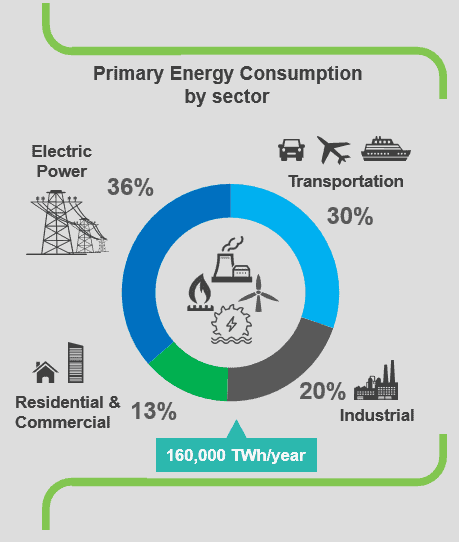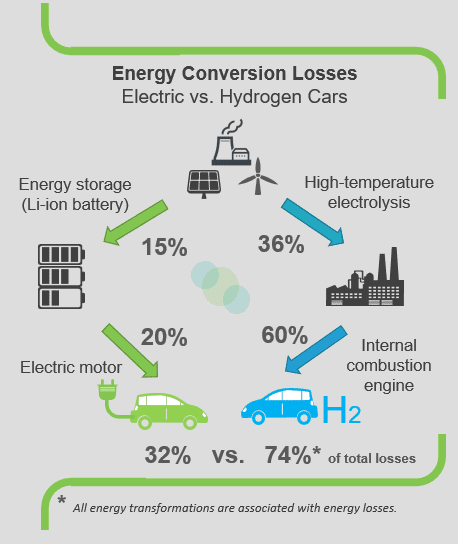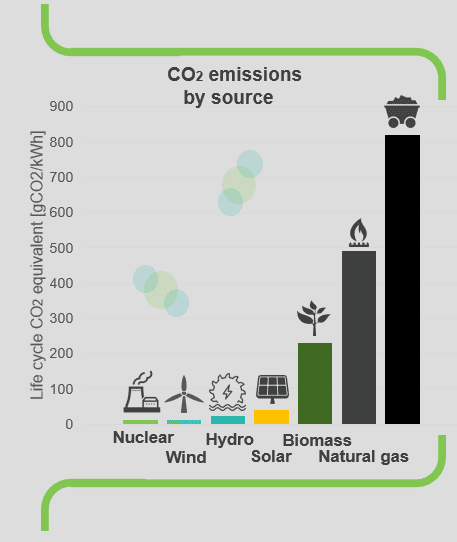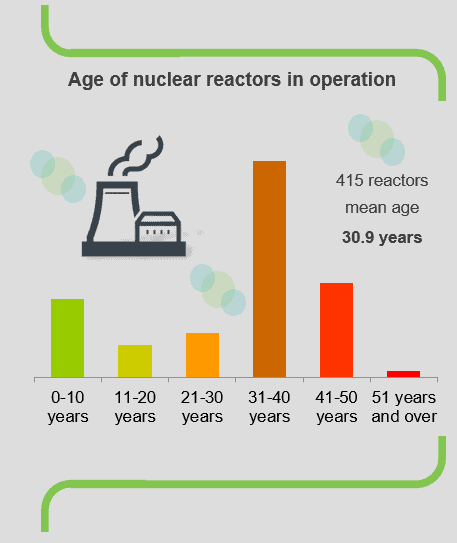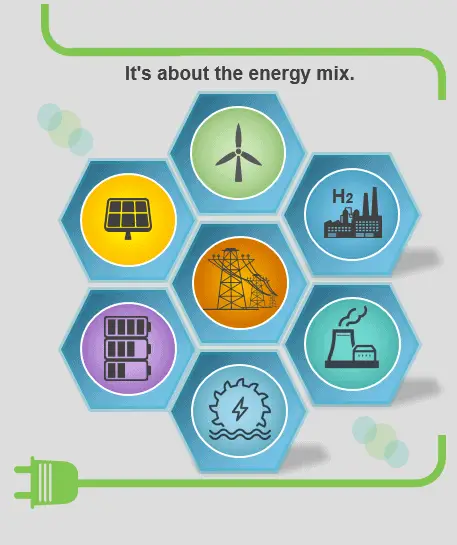Never memorize something that you can look up.
Albert EinsteinThis website provides you with all the information and context you need to understand nuclear power. The best way to promote nuclear power is to present the facts.
A Brief Story of Technology

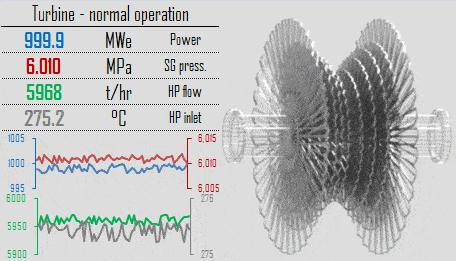
A Brief Story of Energy
To achieve a low-carbon economy without nuclear, renewable electricity generation and storage must be really tremendous.
The uncomfortable truth of decarbonisation is we need to dig a lot of stuff out of the ground to make the world cleaner.
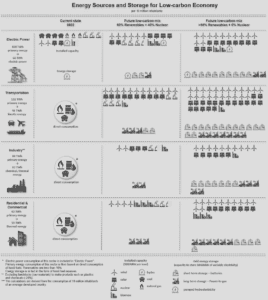 Energy is essential for most activities of modern society. Access to abundant, affordable, secure, safe, and clean energy is beneficial for humans. We use energy in the form of firewood, fossil fuels, and electricity to make life comfortable and convenient. Every product you have at home is most likely made of materials, which were obtained from Earth using a lot of energy. At home, we use electricity for our lights and fans, water heater and room heaters, oven, microwave, washing machine, etc. We use petrol, diesel, CNG for our cars, trucks, buses, etc. A large amount of energy is consumed in agriculture and industry.
Energy is essential for most activities of modern society. Access to abundant, affordable, secure, safe, and clean energy is beneficial for humans. We use energy in the form of firewood, fossil fuels, and electricity to make life comfortable and convenient. Every product you have at home is most likely made of materials, which were obtained from Earth using a lot of energy. At home, we use electricity for our lights and fans, water heater and room heaters, oven, microwave, washing machine, etc. We use petrol, diesel, CNG for our cars, trucks, buses, etc. A large amount of energy is consumed in agriculture and industry.
As of 2018, the world’s main primary energy sources consisted of petroleum (34%), coal (27%), and natural gas (24%), amounting to an 85% share for fossil fuels in primary energy consumption in the world. A large-scale transition away from fossil energy poses a great challenge for society. The current consumption of energy is tremendous. It is hard to imagine that we can rely on one source of energy.
Global direct primary energy consumption in 2020 was about 160,000 TWh (576 exajoules or 545 quadrillions BTU). Assuming that the calorific value of hard coal is 24 GJ / t, then we are talking about the equivalent of 24 billion metric tons of coal. That’s about 20 billion cubic meters. This is equivalent to three hundred million wagons of coal or to a mountain of coal 4 times larger than Mount Kilimanjaro.
Energy consumption is growing steadily.
Global direct primary energy consumption in 2020 was about 160,000 TWh (576 exajoules or 545 quadrillions BTU).
This is equivalent to three hundred million wagons of coal or to a mountain of coal 4 times larger than Mount Kilimanjaro.
We are totally dependent on fossil fuels.
The world’s main primary energy sources consisted of petroleum (34%), coal (27%), and natural gas (24%), amounting to an 85% share for fossil fuels in primary energy consumption in the world.
Climate change is a real problem that you and especially your descendants will face. 90% of coal must remain unextracted and nearly 60% of oil and fossil methane gas must stay underground to have even a 50% chance of keeping global temperatures from rising 1.5 degrees Celsius above pre-industrial levels.
Arctic sea ice is now declining at a rate of 13% per decade.
Industry, transportation, and the residential sector consume even more primary resources than electricity generation.
To achieve a low-carbon economy, electricity generation has to triple and it must be based on low-carbon sources.
Hydrogen and electricity are produced from primary energy, we cannot say that they have the potential to offset fossil fuels.
All energy transformations are associated with energy losses.
Energy exists in many forms. All energy conversions are associated with significant energy losses.
It is desirable to minimize the number of energy conversions and to use highly efficient conversions.
Daily energy storage does not pose a problem. The problem is energy storage to cover the whole year and seasons.
Generation and consumption must be balanced across the entire grid because energy is consumed as it is produced.
Variable renewable energy sources are not dispatchable due to their fluctuating nature, such as wind power and solar power. When it’s cloudy or the wind isn’t blowing, the grid needs more energy from other sources.
The MIT analysis shows a big share of nuclear, a big share of renewables, and some storage is the best mix that is low-carbon, reliable, and at the lowest cost.
Today’s majority of nuclear plants are approaching the end of their design life.
Taking out existing nuclear power plants completely destroys gains with renewables such as wind, biomass, and solar power.
We have to make a final decision on the phase-out of the current nuclear. Indecision can cost us a lot. At present, nuclear energy has been declining for thirty years, and educational capacities and supply chains are in line with this.
A big share of nuclear, a big share of renewables, and some storage is the best mix that is low-carbon, reliable, and at the lowest cost. Without nuclear, demands on the overcapacity of renewables, transmission system, and energy storage systems, would result in excessive use of land and resources.
Future Costs: Opportunities exist to significantly reduce the capital cost and shorten the construction schedule for new nuclear power plants.
Safety: Based on the entire life-cycle, fossil fuels are most dangerous, while nuclear and modern renewable energy sources are vastly safer and cleaner.
Sustainability: Nuclear energy is one of the few sustainable primary sources. It is the only controllable large-scale source that could complement variable renewable sources (wind and solar power), and that could ensure reliable 24/7 energy.
About us
This website was founded as a non-profit project, built entirely by a group of young engineers. The entire website is based on our personal perspectives and does not represent any company’s view in the energy industry.
The primary purpose of this project is to help the public to learn some exciting and important information about energy and the peaceful uses of nuclear energy. We realize that the basics of nuclear physics do not belong to fundamental human knowledge and the term “nuclear” often evokes a feeling of something negative or even dangerous. We do not claim this or that opinion is the only correct opinion. But it is noteworthy that most nuclear engineers, people who know what nuclear means, do not connect the term “nuclear” with anything negative or dangerous.
Anyone can come here, learn the basics of nuclear and reactor physics, and be able to answer basic questions. The best way to promote nuclear power is to present the facts.
